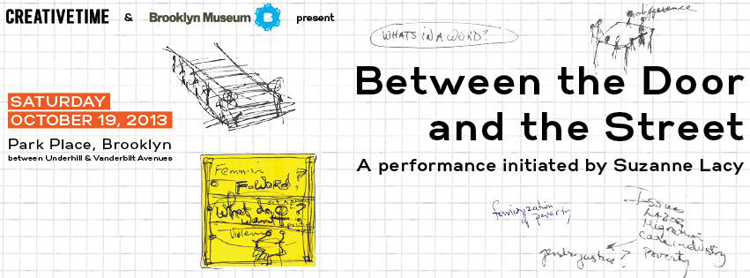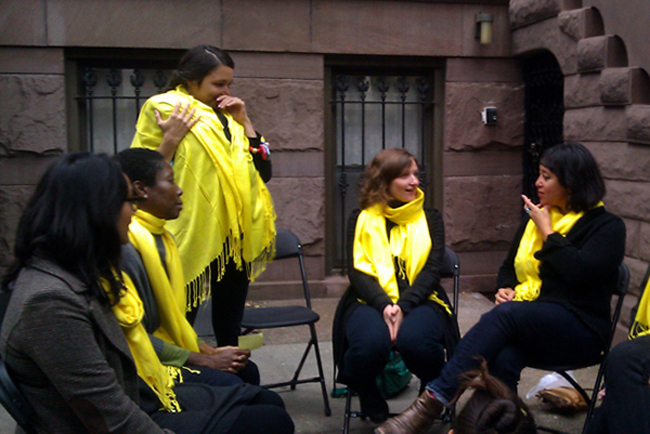Suzanne Lacy: Between the Door and the Street
Topic: Art and Social Practice
Why do women earn less? Is RACE a feminist issue? What’s in it for the MEN?
– Questions that appeared on the steps of the Brooklyn Museum in conjunction with artist Suzanne Lacy’s project Between the Door and the Street in Prospect Heights, Brooklyn
Between the Door and the Street, a project initiated by internationally exhibited artist Suzanne Lacy, brought together over 80 political groups and hundreds of women, as well as a few men, on stoops lining a street in the Prospect Heights neighborhood of Brooklyn to discuss topics related to women’s issues. The project, which took place on October 19th, is one of many contemporary interactive works that seem to have less to do with art and more to do with community activism or creating a forum for community engagement. This is often seen as an advantage to artists working in social practice, which through a shift in our attention to “social form,” as public artist and art theorist Ted Purves explained in a presentation at the 2011 Creative Time Summit: Living as Form conference, allows us to engage with a project’s “capacity” rather than its “quality” or rubrics primarily involved with an art world context.
Related to this methodology, Lacy’s Between the Door and the Street, produced by the Brooklyn Museum and the nonprofit public arts organization Creative Time, began days prior to the event with a series of questions printed on the steps of the Brooklyn Museum (mirroring the steps of the Brooklyn stoops where the conversations from the project would later be held). In bold black letters the questions read “Why do women earn less?,” “What’s in it for the MEN?,” “Who’s winning the war on women?” and “Is RACE a feminist issue?,” directing viewers to the project’s nearby location and bringing to mind both issues facing women and those associated with “the F word,” as Lacy calls it, feminism itself.
For the Between the Door and the Street event, members from community organizations including the New York Asian Women’s Center, Girls for Gender Equity, the Dominican Women’s Development Center, the Brooklyn Historical Society: Crossing Borders, Bridging Generations, among many others, were asked to participate as performers in the project, taking part in unscripted conversations prompted by questions they came up with beforehand. While they talked among themselves, audiences walked up and down the street, listening in on topics ranging from immigration rights and wage discrimination to family dynamics and childcare issues, with opinions voiced by women from a variety of different ages, backgrounds and ethnicities.
While some audience members had a difficult time getting close enough to hear the conversations, others had a difficult time with being instructed not to join in. As one passerby said to her friend while overhearing part of a conversation among women from the Brooklyn Historical Society, “Its hard not to say anything.” This though, was followed by the final portion of the piece where performers left their positions on the stoops and met the audience members in the street for some apple cider. Transformed by the performance into unique social setting, the final hour on the street provided the opportunity for collective conversations and a continuation of some of the most engaging stoop discussions. To read more about the project, check out the project on Creative Time’s Website: http://creativetime.org/projects/between-the-door-and-the-street/
– Liz Janoff

